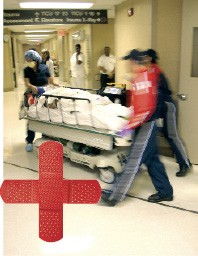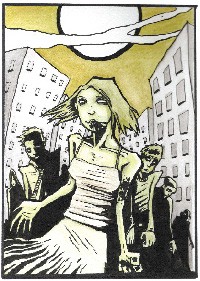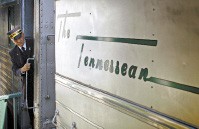One evening last May, 22-year-old Patrick Sawyer was playing kickball. It was getting dark, but the game was in full swing. He and his friends were swigging beer, and Sawyer was in high spirits.
After an enthusiastic kick at an oncoming ball, the Memphis Pizza Café employee lost his footing. In one fluid movement, his right foot slipped under him, and he heard a dull crack.
Sawyer had broken his ankle. And with his wrong move, he became one of more than 60,000 uninsured patients treated each year at the Regional Medical Center, commonly known in Memphis as The Med.
Fortunately for them, Shelby County mayor A C Wharton has convened a blue-ribbon panel to help decide the future of The Med. At the panel’s first meeting in May, Nelson Toebbe, then-interim chief of The Med, gave an impassioned presentation on the 178-year-old hospital’s fiscal problems and the harsh reality it is facing.
“We need to come up with an ongoing solution to these problems,” Toebbe said. “If they continue, we’ll have nowhere to go. We will have to close.”
The Med’s problems stem from the rising cost of health care coupled with treatment of uninsured patients, especially those from out of state. The cost of hiring temporary staff also plays a role, as does the cost of maintaining the aging facility located on Jefferson Avenue.
“The Med cannot possibly continue to operate as it has in the past,” said Travis Smith, chairman of The Med’s finance committee. “We are living on a day-to-day basis. We must seek long-term stability, or we will fail.”
Code Red
Part of the panel’s mission is to identify other revenue sources for the hospital. As it stands now, The Med ends each year in worse financial shape than the previous one.
The Med, which costs about $1 million per day to operate, spans two city blocks and consists of six buildings. For the 2006-’07 fiscal year, which ended June 30th, the hospital budgeted $314 million in expenses and expected to end the year with a $20 million deficit. The deficit was only $3 million.
As is typical each year, The Med managed to pull its way out of crippling debt. With no additional government support and with the rising cost of health care, Smith said it’s gotten harder to pay the hospital’s bills.
“When you get to the end of the year, you say, ‘Oh, looks like we’re going to make it,'” Smith said. “Then you have to start over and hope you can do the same thing again.”
During The Med’s last fiscal year, 72.9 percent of its revenue came from patients and their insurance companies. The state of Tennessee added 11.5 percent of operating budget, and Shelby County provided another 10 percent. MedPlex Pharmacy and other subsidies provided 5.5 percent of the hospital’s revenue. Mississippi and Arkansas also provided 1.1 percent of The Med’s overall budget to cover costs incurred by patients from those states.
“We never borrow,” said Jack Morris, president of the hospital’s board of trustees, “so we have to depend on the kindness of others.”
On Call, 24/7
The Elvis Presley Memorial Trauma Center at The Med has been in operation for nearly 25 years. As a Level 1 trauma center, it is always open and always staffed with a number of specialists.
If a motorcyclist has an accident on I-40, a trauma surgeon will be there to repair the damage. An anesthesiologist will be on-hand to administer painkillers. An X-ray specialist will figure out if there are broken bones, and an orthopedic surgeon will repair them. A heart specialist and a brain specialist will also be ready.
Martin Croce has been with The Med for more than 18 years and has been the trauma center’s medical director since 2000.
“Back in the late ’70s, a lot of people were dying from very simple injuries, such as a spleenic injury, which is very easy to take care of,” Croce said. “But people weren’t available to care for those particular injuries.”
A patient’s chance of surviving a traumatic injury becomes substantially less if they don’t receive treatment within an hour — what medical personnel call the “golden hour.”
“Most patients can tolerate blood loss, among other things, for about an hour. Overall, unless the patient is seen within the hour, survival rates are cut in half,” Croce said.
The Med has the only Level 1 trauma center within a 150-mile radius. Other Level 1 centers are located in Nashville at Vanderbilt Medical Center and in Jackson, Mississippi, at the University of Mississippi. But residents of Memphis and the Mid-South, including portions of Arkansas, Mississippi, Kentucky, and Missouri, must come to The Med for trauma-related treatment to be helped within the golden hour.
The majority of the Mississippi and Arkansas patients admitted to The Med during the last fiscal year — about 75 percent of them — were admitted to The Med’s trauma center. And their care was expensive. Treating uninsured Mississippians cost The Med $15.5 million. Patients paid $4.2 million of that amount, and the state of Mississippi kicked in $2.3 million. But that left The Med $9 million in the hole.
The Med spent almost as much, $13.4 million, on care for uninsured patients from Arkansas. After those patients paid $2.9 million and the state of Arkansas gave The Med $1 million, the hospital ended up with a $9.5 million loss.
 Jonathan Brizendine | dreamstime.com
Jonathan Brizendine | dreamstime.com
The hospital’s liquid assests also reflect its vulnerability. A facility like The Med should operate with 90 days’ worth of cash on hand. At times last year, The Med only had four to six days’ worth of cash on hand. The average for the fiscal year was about 20 days of cash.
Self-Pay
Despite the toll of uninsured patients on The Med, the hospital continues to accept all patients.
“We’re a safety-net hospital,” Morris said. “That means anyone and everyone. It’s not a part of our mission statement to turn people away. We’ll help you whether you have insurance or not, and then we’ll work it out from there.”
The trauma center’s Croce agreed: “For one thing, [turning away the uninsured] is not the right thing to do. Our goal is to treat the patient. It would be great if they pay their bills, but that doesn’t determine who gets treated.”
Nationally, the cost of health care is rising 6 to 7 percent each year. Private insurance premiums are increasing at a rate of 12 percent per year, according to the National Coalition on Health Care. As a result of the increase, patients who can no longer afford health insurance turn to emergency rooms for primary care. And when patients can’t pay the resulting bills, The Med’s budget takes another hit.
TennCare, the state’s insurance provider for low-income residents, also contributes to The Med’s financial problems. In 2005, more than 160,000 people were dropped from TennCare following stricter eligibility guidelines championed by Governor Phil Bredesen.
What immediately followed was a 5 to 7 percent spike in the number of patients at The Med who could not afford to pay their medical bills. In fact, 32 percent of all patients at The Med are now responsible for their bills since the changes to TennCare. They are called “self-pay” patients officially, or “no-pay” patients unofficially.
Jeff Strawn, controller at The Med, remembered the fallout from the TennCare change. “It hurt us to the tune of $7 million to $8 million … because a lot of people who should have coverage suddenly didn’t.”
But that didn’t stop patients from coming to The Med for treatment.
“In the overall scheme of things, The Med is different from Baptist Hospital,” Morris said. “There are no private insurance company patients. Big hospitals have that — it’s how they make their money. On insured patients, you make more than it costs to provide care and thus [make a] profit. With the government insurers, like Medicaid, Medicare, or TennCare, you only get close to breaking even.”
Self-pays, he said, are one of the biggest reasons why The Med is slipping into the red.
But still, no one is turned away.
When Sawyer broke his ankle, an ambulance drove him to The Med’s trauma center. Once there, he waited for five hours as higher-priority patients came through the door. Around midnight, he was able to leave the hospital with a temporary cast and an order to go to surgery in the next few days.
“I didn’t even get a bill,” Sawyer said.
 Brad Jones
Brad Jones
The Regional Medical Center on Jefferson Avenue operates the only Level 1 trauma center within a 150-mile radius of Memphis.
Judy Briggs, executive director of revenue cycle for The Med, said that Sawyer’s case is typical of the hospital’s billing practices.
“If patients are uninsured, they usually get their first bill seven to 10 days after discharge. There are exceptions to that rule, of course. For example, we don’t send a bill if there is further care relating to that particular injury,” Briggs said.
Three days after Sawyer broke his ankle, surgeons screwed an internal metal support bar to his bones.
“I didn’t have any insurance or anything, but everyone was really nice,” Sawyer said. “The surgery went fine. And they wrapped me up and sent me home for two weeks with a temporary cast to let my wound heal.”
The Med has a payment system to determine how much uninsured patients are charged. If a patient’s income is 150 percent or less of federal poverty guidelines, the bill is written off as charity. For those patients making 150 percent to 300 percent of federal poverty guidelines (about $21,000 to $41,000 for a family of two), The Med will discount the patient’s bill.
During the last fiscal year, The Med wrote off $219 million in charity and $131 million in bad debt.
Staff Shortages
Brenda Pullen, director of nursing at The Med’s Newborn Center, has another problem.
“We’re suffering from a nurse practitioner shortage,” Pullen said. “We have lost six of our 12 nurse practitioners. They are the backbone of care for infants.”
Neonatal nurse practitioners are highly trained nurses who specialize in the care and treatment of infants, especially those born with serious health problems. In the Newborn Center, neonatal nurse practitioners decide the treatment plan for most infants there.
The lack of nurse practitioners also strains The Med’s budget. When a hospital is unable to hire enough staff nurses, it hires help from nursing agencies.
“The upside is that they can come in and help for short periods of time,” Pullen said. “The downside is that we don’t get to keep them.”
Not only do agency nurses get hired at a higher pay rate than staff nurses, the hospital also has to cover the costs of lodging and traveling.
“We’re unable to recruit and train enough nurses here because of the national shortage,” Travis Smith said. “And now, we’re paying overtime to the nurses we have and spending more money on agency nurses. It’s an inefficient way to staff.”
During their worst nursing shortage, in May, the 60-bed Newborn Center was forced to send three infants to Baptist Women’s Hospital.
The shortage of staff does not apply to the Newborn Center alone. Two weeks after his surgery, Sawyer arrived at 9:30 a.m. to get his permanent cast. He did not leave the orthopedic wing until 5 that evening.
“The guy who did my cast was actually complaining that they were understaffed,” Sawyer said. When he left the hospital, there were still people who had been in line before him waiting for the treatment, he said.
“We just make do”
Equipment and maintenance costs add to The Med’s troubled bottom line.
“We have enough money to maintain and operate The Med,” Smith said, “but we simply don’t have enough money to make improvements in what we already have. We’re falling behind the curve.”
Louis Fort, vice president of support operations at The Med, agreed, saying that the aging hospital is out of date and decaying fast:
“We only get $12 million to $13 million each year to take care of [our six buildings]. And that includes biomedical [equipment], not just building maintenance.”
Jeff Strawn said that the actual cost of keeping The Med and its equipment up to date would be about $30 million per year. Instead, the hospital has to defer about $17 million in maintenance costs each year.
“We don’t buy as much equipment as we should,” Strawn said. “We lose a little more money than we should. We don’t hire as many people as we really need. We just make do. It’s like your family budget at home. If you don’t have the money, you don’t spend it,” Strawn said.
This year, The Med is in the process of adding a picture archive communications system, or PACS, to its X-ray machines. The PACS allows radiologists to send digitized images of X-rays between computer workstations, making the system more efficient and creating a permanent image for the hospital’s archives. Computer screens, software, and workstations are all expected to be updated for PACS by mid-August. The upgrade will cost $3 million, or about 23 percent of The Med’s total maintenance budget.
Basic building maintenance is often neglected in favor of more pressing updates to medical equipment, Fort said.
“We did a facility assessment in 2005, and we found that some of the equipment is reaching its life expectancy,” Fort said. “Some of the air handlers, which are nothing but big pieces of equipment that distribute warm and cool air, haven’t been changed since the 1950s.”
If the air handlers were to break, the quality of care in The Med would rapidly deteriorate. The air in the hospital would become stagnant. Equipment could overheat, and the humidity would create a breeding ground for germs.
“The patients would have to be moved elsewhere,” Fort said. “The hospital would have to close.”
A full upgrade of The Med’s infrastructure, including all 72 of the hospital’s air handlers, would cost $32 million.
Looking for a Cure
On July 19th, the blue-ribbon panel met again to discuss its progress on finding a solution to The Med’s financial crisis.
Little had changed between the May and the July meetings of the panel, but The Med’s board had hired a new company to run the beleaguered hospital, and The Med had a new interim CEO.
Sylvester “Skip” Reeder was selected as the hospital’s third interim CEO after The Med’s board chose New York-based FTI Cambio Health Solutions to run the hospital for up to 18 months while the board searches for a permanent head.
During the panel meeting, member William Rhodes, CEO of AutoZone, suggested that The Med close if no lasting solution is found.
But A C Wharton and others cautioned panel members to consider the social costs of shuttering the only safety-net hospital and trauma center in the region.
“If The Med closes, it would be almost impossible for [Methodist/Le Bonheur] to absorb all that volume,” said Gary Shorb, CEO of Methodist Le Bonheur Healthcare.
Gene Holcomb, former chairman of The Med’s finance committee, suggested cuts to administrative expenses and a closer examination of spending by specific hospital departments.
“Only rehab comes close to breaking even,” Holcomb said. Most departments, he pointed out, actually lose money. Cutting certain departments and partnering with another hospital might be good ways to save money, he said.
Despite The Med’s financial crisis, the hospital isn’t likely to close anytime soon, Jack Morris said. But like safety-net hospitals across the country, The Med’s continual lack of funding could lead to its demise.
The panel is expected to present possible solutions in late September.
As for Sawyer, he got his cast removed July 5th. He is wearing a temporary boot while the broken bones in his ankle fuse into place.
“I haven’t gotten my bill yet,” he said. “I’ve got a final appointment on August 8th. I think that once they take the boot off and make sure I’m okay, I’ll get the bill a few days after that.”
His accident will eventually cost him — or The Med — $9,000.

 Justin Fox Burks
Justin Fox Burks